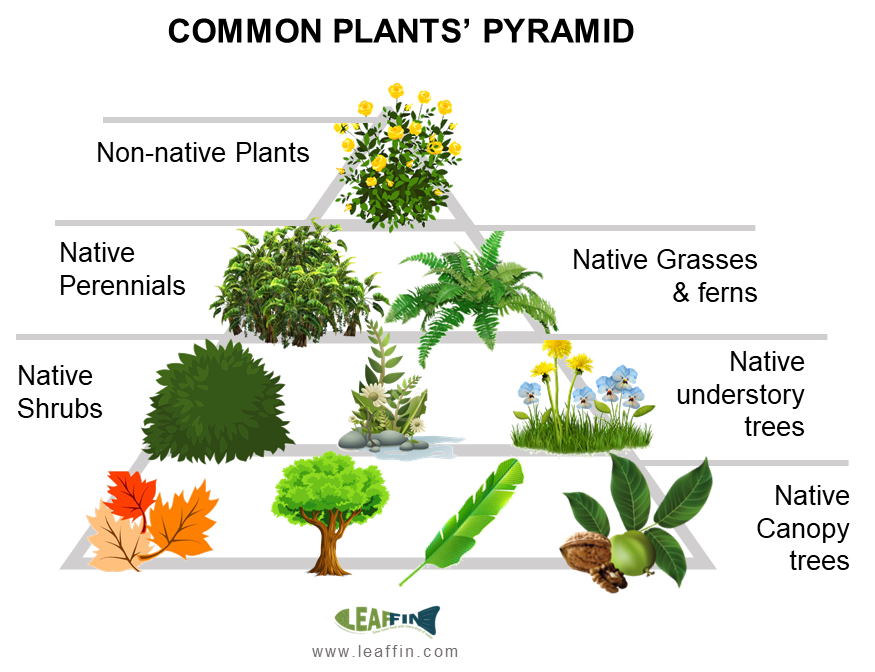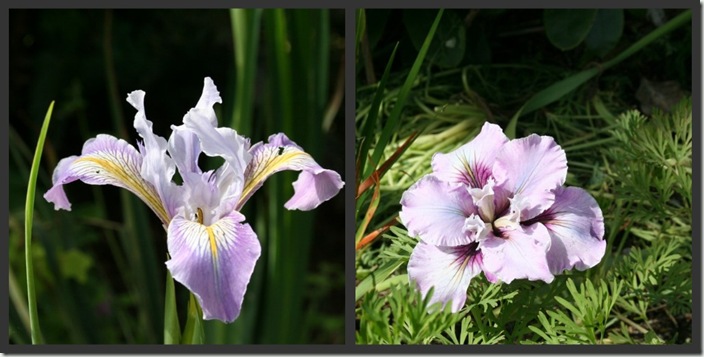People that are just dipping their toe into the concept of using more native plants in their garden often wonder how many they should use. Reluctant to let go of some of their favorite non-native plants, they look for a recommended balance.
We’ve all seen the food pyramid, with healthier foods forming the base and chocolate cheesecake with cholesterol sauce at the top (mmmm…. cholesterol sauce). Though nutritionists argue about the specifics, it’s a great concept because it makes healthy eating a bit simpler to visualize.
Preserving the connections between wildlife and the plants that support them is just like healthy eating – there’s no need to be extreme and cut out the roses, dahlias and “dessert” plants that bring you joy. Life’s better when we indulge a bit.
Flaura & Fauna connection
But there’s also no denying that many insect and animal species rely on very specific types of plants in order to breed and eat. We don’t yet understand all the connections between plants and wildlife, but one thing is clear: plants have evolved over time alongside the insect and animal populations that feed and reproduce on them, so planting a variety of plants native to your area is one of the simplest ways of helping out your local wildlife.
But planting for wildlife can be rife with questions and unknowns. Is something still native if it normally grows in a different part of the state? Is that gorgeous cultivated variety of a native plant still helpful?
Native Plants Pyramid
In the interest of keeping things simple, we can use the pyramid concept as a way of visually imagining what role non-native plants might play in your garden. With this concept, it is easier to envision a goal for what your plant palette might look like.

Regional note: The suggested chart here is generally for the southeastern U.S.; southeastern coastal areas might have a slightly different mix. A teammate was quick to point out, for example, that a chart for the midwestern U.S. would have mostly grasses and forbs (perennials) and fewer trees.
The largest category, from the perspective of total biomass, is native trees, particularly canopy trees. Canopy trees would include oak, maple, hickory, pine (and other large conifer families), elm, beech, tuliptree as well as others.
Woody natives: On the whole, woody plants like trees and shrubs provide food and shelter to the greatest variety of wildlife. So when choosing where you can have the most impact on your local wildlife, shrubs and trees can be a better bet than perennials and small flowers.
Depending on the size of your property, you may only have one or you may have many. Remember this is relative to the size of your overall plant biomass. These large plants will contribute a significant amount of services to your local wildlife as many of them are top insect supporters, provide substantial food mast (acorns, nuts, seeds) and create large areas for shelter. In addition their roots provide erosion control and form large micorrhizal fungi networks below ground that help sustain the network of life in the soil.
The next two categories are native shrubs and understory trees. These plants support different wildlife such as different insect hosts, different fruits/seeds, and provide different habitat due to their shapes and sizes.
The final two native categories are native perennials: flowering perennials on one side and native grasses and ferns on the other. Although smaller in biomass, the impact of these plants is not to be denied both for wildlife and our own enjoyment.
Perennials offer a chance to provide nectar and pollen-rich blooms for many months, long after most trees are done blooming. In particular, the fall-blooming native perennials like goldenrod (Solidago), eupatorium (Eupatorium/Eutrochium), blazing star (Liatris) and aster (Symphyotrichum) sustain many pollinators as they head into the winter months.
Songbirds feast on the seeds of these and many others if stems are left in place until spring. Some insects nest in those stems over the winter, providing a source of protein to the birds that discover them.
Grasses provide seeds, nesting materials and shelter for many birds and small mammals. Ferns are used for both nesting and shelter as well. Grasses are also host plants for some butterflies/moths.
This leaves you with the top of the pyramid and the category that you would use sparingly or consider to be your dessert. Choose plants that have special meaning but which are not considered invasive. In my garden I have gardenia, tea olive, a few daylilies, and a potted dwarf date palm. I also use annual zinnias because they are a good nectar source. I do have a lawn, another non-native feature, but one that shrinks a little bit each year as I chip away at the sides to enlarge my native perennial beds.
Landscaping
Many natives are being bred to have better characteristics for landscaping, such as more brilliantly-colored flowers, ruffly blooms, or a variety of sizes that fit into home gardens more easily. While the naturally-occurring plant variety is sure to be a good fit for wildlife, it’s likely that many of the wildlife benefits of native plants are still found in hybrids and selected varieties.
However, there are two times when cultivated varieties of natives are definitely not as helpful:
When flowers have become more ruffly or have changed shape in some way. Flower shape is really important in allowing pollinators to feed, so when people breed in more petals, they often breed out wildlife value. Even so, a floofy-petaled native still retains more wildlife benefit then its non-native counterpart, because there may be other insects, birds, or beneficial soil microbes that can still form a community with the plant.

When the cultivated variety is of a single sex. For example, Garrya elliptica ‘James Roof’ is a male version of my locally-native silk tassel. It’s been bred to have longer tassels and no fruit, which makes it more visually appealing during tassel-time, and easier to plant in commercial installations such as in a parking lot, where fruit can be slippery and messy. The problem with this is that local birds are used to eating the fruit from female silk tassels, so when only the male is planted, birds lose out on a nutritious feast.
Bottom line? Cultivated varieties of natives are still highly beneficial, but if it’s not a big difference to you, a locally-grown species is often the most helpful for wildlife.
It’s also about mindfulness. If a non-native dahlia that needs protecting from pests makes your soul sing, then by all means, plant some dahlias! But plant them right up where you’ll see them every day, and only plant as many as you need to lavishly participate in the dahlia-loving experience. Then nestle in a couple of native shrubs and some edible plants alongside so that your dahlias take their place within a deliciously varied and useful landscape.
Generalist wildlife value & feeding people
Generalist wildlife value: Many birds and insects are “generalists”, that is, they can drink most types of nectar, eat most kinds of seed or berry, and generally get along fine with whatever food we care to provide in our gardens for them.
These types of wildlife are usually not in danger of going extinct, so we don’t usually worry about their numbers in the way we do “specialist” bugs and birds, which rely on particular natives to survive. However, it’s still a fine thing to provide food and shelter to them, and they are easy to attract and enjoy watching in your garden.
Plants that have good generalist value are non-native ornamental grasses and seed-setting perennials, shrubs with berries, and plants with ample nectar like those in the mint family. Woody plants – shrubs and trees – are also of great benefit to wildlife because they provide places to nest and hide.
Feeding people: Humans are wildlife, too, and though we aren’t reliant on our backyards to feed us, it’s a noble thing to become more so! The gas/ oil used in shipping food to us, and the chemicals used in agriculture have a detrimental effect on our wildlife populations. Feeding yourself fresh, healthy food from your garden or a local organic farm is hugely beneficial in protecting wildlife.
Remember that the goal here isn’t “perfection”, whatever that is. It’s about finding a balance in your own garden that allows you to contribute to the environment as effectively as possible, while leaving ample room for you – your artistic input, your hobbies, and your experience of the garden.
I hope you find this useful as you ponder how to transition your garden towards more native plants. If you’re looking for guidance, we’re all here for you.
